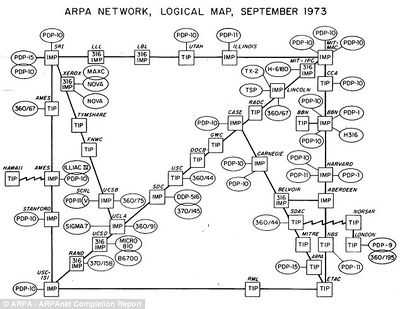Advanced Research Projects Agency Network (ARPANET)
What is Advanced Research Projects Agency Network (ARPANET)?[1]
The Advanced Research Projects Agency Network (ARPANET), the forerunner of the Internet, was a pioneering long-haul network funded by the U.S. Department of Defense’s Advanced Research Projects Agency (ARPA). It served as the test bed for many areas of internetworking technology development and testing and acted as the central backbone during the development of the Internet. The ARPANET was built using packet-switching computers interconnected by leased lines.
Historical Overview of Advanced Research Projects Agency Network (ARPANET)[2]
The ARPANET was a project funded by the U.S. government during the Cold War, in order to build a robust and reliable communications network. This was done by connecting various computers that could simultaneously communicate in a network that would not go down and continue running when a single node was taken out. The initial groundwork for a computer network was laid by Joseph C. R. Licklider of Bolt Beranek and Newman (BBN). Licklider became the head of the behavioral sciences and command and control programs at ARPA in October 1963. He then convinced Ivan Sutherland and Bob Taylor to work on this concept. In his office, Bob Taylor had three computer terminals connected to the three ARPA-sponsored computers:
- The System Development Corporation (SDC) Q-32 at Santa Monica
- Project Genie at the University of California, Berkeley
- Multics at the Massachusetts Institute of Technology
When Taylor needed to talk to someone on another computer, he would transfer to a different terminal for each connection. This was frustrating and led to the concept of one terminal/computer connected to a number of other terminals. This idea paved the way for the ARPANET and, eventually, the modern Internet. Paul Baran of Rand Corporation concluded that the strongest kind of network would be a packet-switched network that would use any available communication line, regardless of the status of other lines. The ARPANET originally connected four computers, as follows:
- A Honeywell DDP 516 computer at the University of California, Los Angeles
- An SDS-940 computer at the Stanford Research Institute
- An IBM 360/75 at the University of California, Santa Barbara
- A DEC PDP-10 at the University of Utah
Compatibility issues surfaced as more computers were connected to the network. These problems were solved in 1982 through the development of Transfer Control Protocol/Internet Protocol (TCP/IP).
Deployment of ARPANET[3]
The initial ARPANET consisted of four IMPs:
- The University of California, Los Angeles (UCLA), where Leonard Kleinrock had established a Network Measurement Center, with an SDS Sigma 7 being the first computer attached to it;
- The Augmentation Research Center at Stanford Research Institute (now SRI International), where Douglas Engelbart had created the ground-breaking NLS system, a very important early hypertext system, and would run the Network Information Center (NIC), with the SDS 940 that ran NLS, named "Genie", being the first host attached;
- The University of California, Santa Barbara (UCSB), with the Culler-Fried Interactive Mathematics Center's IBM 360/75, running OS/MVT being the machine attached;
- The University of Utah School of Computing, where Ivan Sutherland had moved, ran a DEC PDP-10 operating on TENEX.
The first successful message on the ARPANET was sent by UCLA student programmer Charley Kline, at 10:30 pm on 29 October 1969, from Boelter Hall 3420. Kline transmitted from the university's SDS Sigma 7 Host computer to the Stanford Research Institute's SDS 940 Host computer. The message text was the word login; on an earlier attempt the l and the o letters were transmitted, but the system then crashed. Hence, the literal first message over the ARPANET was lo. About an hour later, after the programmers repaired the code that caused the crash, the SDS Sigma 7 computer was affected by a full login. The first permanent ARPANET link was established on 21 November 1969, between the IMP at UCLA and the IMP at the Stanford Research Institute. By 5 December 1969, the entire four-node network was established. Figure 1. below is a map published by the Advanced Research Projects Agency for the ARPANET shows the system had just 42 computers connected to 36 nodes in September 1973.

source: TechPowerUp
See Also
Defense Advanced Research Projects Agency (DARPA)
References
